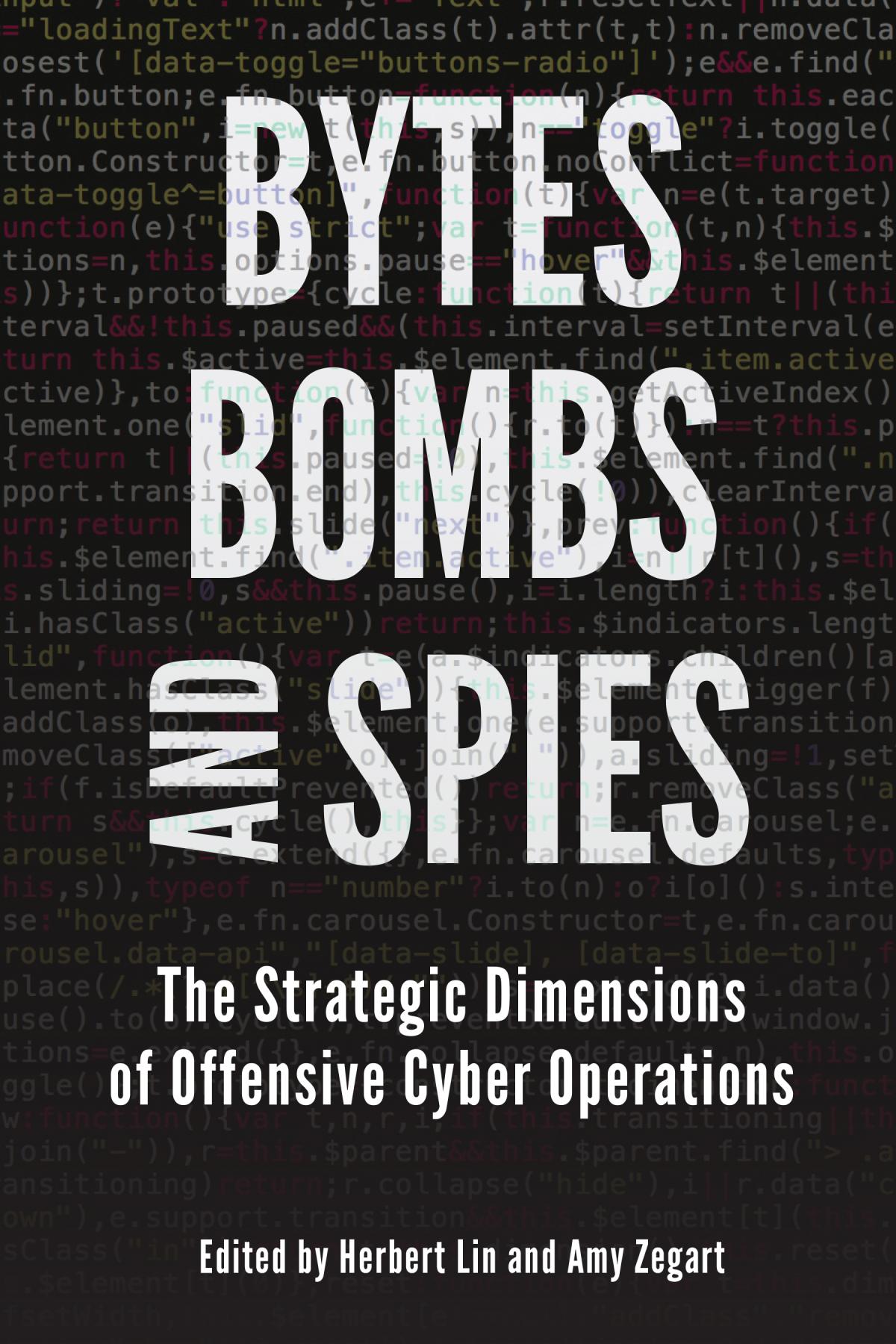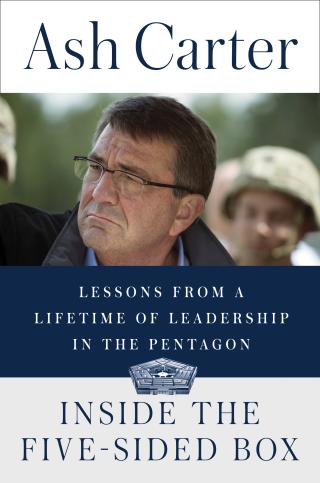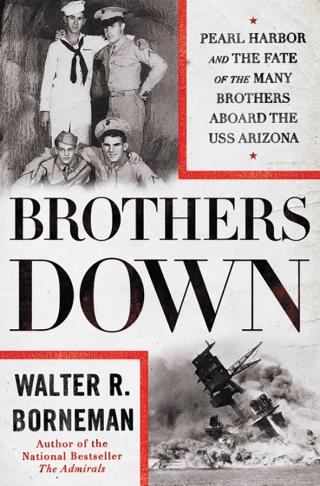Bytes, Bombs, and Spies: The Strategic Dimensions of Offensive Cyber Operations
Herb Lin and Amy Zegart, eds. Washington, DC: The Brookings Institution Press, 2019. 438 pp. Notes. Index. $45.99
Reviewed by Lieutenant Brandon Karpf, U.S. Navy
Join me on a stroll down memory lane. September 2007: Israeli cyber operators remotely suppress Syrian air defenses. December 2015: Russian hackers destroy Ukrainian infrastructure and 200,000 Ukrainians lose power. March 2019: China reportedly hacks 27 U.S. universities to steal naval technologies. March 2019: Iranian hackers attack banks and governments in the U.K., United States, and Saudi Arabia. May 2019: Israel conducts airstrikes to kill Hamas cyber operatives—the first reported use of kinetic force in response to a cyber attack.
This list represents a fraction of the interconnections between cyber operations and modern geopolitical competition. How does a country plan for, interpret, and respond to these actions? When should a state posture and engage with an adversary through cyberspace? When does cyberspace become physical space? These are some of the questions considered in Bytes, Bombs, and Spies, an omnibus for cyberwarfare strategy edited by Herb Lin and Amy Zegart, codirectors of the Stanford Cyber Policy program.
The book explores four strategic dimensions of cyber operations: strategy and doctrine for using cyber weapons; operational considerations for using cyber weapons; cyber deterrence and escalation; and the private sector’s role in supporting offensive cyber operations. Policy makers rejoice! You finally have an approachable guide through the cyber quagmire.
Anyone with technical chops will notice the classic errors of our soft-science brethren—mistakes in characterization, enumeration, and identification. But those who actually work with bytes, bombs, and spies are not the target audience. It’s all in the name: The Strategic Dimensions of Offensive Cyber Operations. Less a book for the budding cyber operator, it’s written for two communities. The first are policy analysts trying to hack their way into the world of cyber. The second are tacticians ceding their keyboards for more strategic endeavors.
The authors understand cyberwar as an intellectual pursuit. In that vein, they provide something for every type reader. Some chapters are narrative. Many are historical and academic. Some are fantastical. One is a rigorous human-factors study (a welcome respite from the flanking pages of cerebral theorization). The chapters cover cyber terrorism and arms control to game theory. It’s a fun read if for the shear variety of style and content.
The work does suffer from one notable fallacy. It relies on nuclear weapons as a reasonable analogy to the intent and strategy of cyber operations. The word “nuclear” appears almost as often as “cyber”—further evidence that the authors attempt to fit this brave new world into an old pair of sneakers. If cyber policy is to evolve, it must expand beyond 20th-century grand strategy.
That said, the book does its job and does it well. It provides 15 standalone essays that build a robust synopsis of the landscape of cyberwarfare strategy. Its most prescient conclusion is how lacking the field remains.
Bytes, Bombs, and Spies opens the interdisciplinary and interprofessional discussion on cyber strategy—a worthy pursuit in today’s national dialogue. Within a decade of the first nuclear weapons tests, Herman Kahn, Bernard Brodie, and John Foster Dulles pledged themselves to the functional crucible of U.S. grand strategy. The lack of a similar effort for cyberwarfare is appalling. This book starts to fill that barren cauldron.
■ Lieutenant Karpf is a Navy cryptologic warfare officer. He is an operations officer for U.S. Cyber Command, Joint Force Headquarters, Cyber, Fleet Cyber Command.
Inside the Five-Sided Box: Lessons From a Lifetime of Leadership
Ash Carter. New York: Dutton, 2019. 434 pp. $30.
Reviewed by Captain Joshua Himes, U.S. Navy
Even for those who have spent one or more tours serving in the Pentagon, the Department of Defense (DoD) headquarters is a complex and multidimensional institution. Few have the collective years of service and breadth of experience to address such a daunting topic as the 25th Secretary of Defense, Ash Carter.
In this memoir, Carter blends personal insights with a laymen’s approach to understanding the full spectrum of responsibility of the Secretary of Defense. From his pragmatic, scientific roots, and his nearly 36 years of service, Secretary Carter structures his journey through DoD with five sections along the department’s primary lines of effort.
He begins with a focus on acquisition and the military industrial complex and provides illustrative vignettes. He pulls from his early scientific work on Star Wars to reinforce a key theme throughout the book: political expedience and agenda may create friction in the department, but truth as “an essential compass” usually will win the day—one of many not-so-subtle digs at the current administration.
Carter then describes his key external partnerships, to include the White House, Congress, and the press. This section contains some of the most insightful inside perspective from the Obama administration, and Carter again leverages the narrative to provide lessons on leadership and navigating the choppy waters of the Beltway.
He addresses military command, control, and combat operations in section three, including vignettes on defeating ISIS and nuclear-war planning. He uses the “Defeat ISIS” campaign to convey the importance of a clear, concise narrative and a realistic definition of victory to build political and diplomatic momentum for military objectives. He also delves into dealing with operations gone awry and recounts his actions and leadership following the October 2015 bombing of a hospital in Konduz, Afghanistan.
Carter then steps back for an expansive look at the formulation of national strategy and delves into critical global and regional threats. Using the term “anodyne vagueness” to describe prior strategies, Carter characterizes hot spots and his imperative to redefine high-tech innovation as an existential enabler for high-end warfare in the future.
Saving the most important element for last, Carter ends with a focus on the people of DoD, and the book’s underlying heartbeart speaks of leaders, soldiers, and families. He goes into unexpected depth on a very personal and difficult topic, the dismissal of his senior military assistant following allegations of misconduct, providing a compelling window into the Secretary’s most valued attributes of trust and honor. He spends greater energy focused on the force of the future, his efforts to integrate women into combat roles, and his commitment to honoring the wounded and fallen.
Although most will not find this a contentious, tell-all account, Secretary Carter pulls no punches when characterizing the Trump administration’s approach to many topics, such as the military’s transgender policy, North Korean diplomacy, alliances, and Muslim bans. He also has candid comments for National Security Agency leaders who he does not believe were held to account following Edward Snowden’s betrayal.
This memoir provides a valuable addition to collective insight into the E-ring and should be added to future leadership reading lists. Don’t be surprised if it serves as the core of a future Belfer Center lecture series, with focus on the epilogue, aptly named “A To-Do List for a Future Secretary.”
■ Captain Himes served in the Pentagon on the Joint Staff from 2007 to 2010 and is a career naval intelligence officer. He currently is the commander of the Joint Intelligence Center, Central Command.
Brothers Down: Pearl Harbor and the fate of many brothers aboard the USS Arizona
Walter R. Borneman. New York: Little Brown and Company, 2019. 368 pp. Appx. Notes. Biblio. Photos. Maps. $19.99.
Reviewed by Master Chief David Mattingly, U.S. Navy (Retired)
The story of the Japanese attack on Pearl Harbor has been told, both in fiction and non-fiction, through the eyes of military leaders as well as the sailors and soldiers whose calm Sunday morning turned to tragedy. However, noted naval historian Walter R. Borneman, author of The Admirals, brings out a new and very emotional story of Pearl Harbor—the story of the brothers stationed together on board the USS Arizona—in his book Brothers Down.
The fate of the five Sullivan brothers on board the USS Juneau is well-known and memorialized, both in the naming of two destroyers as USS The Sullivans and a 1944 movie titled The Fighting Sullivans, which opened as U.S. and allied forces moved across the Pacific. Borneman writes the story of 63 brothers who died on the Arizona and a few who, by fate, survived because they were ashore on liberty or by sailors’ or Marines’ luck.
Many mistakenly believe that there were rules or regulations that prohibited siblings from serving in the same command, or that regulations were enacted after the sinking of the Juneau. Instead, the Navy saw value in family ties as a recruiting tool. Borneman points out a “photo of an older brother . . . in a handsome uniform was better than any recruiting poster.”
The Becker family of Kansas had suffered through the dustbowl of Kansas. The second son, Harvey, joined the Navy, and after boot camp at Great Lakes reported to the Arizona to become a gunner’s mate. His brothers Marvin and Wesley joined in 1939 and 1940, respectively. After boot camp, they received orders to the Arizona, and emulating the oldest brother, they wanted to work with the ship’s guns. The three served in the same gun turret.
How the crews of the ships reacted to the first bombs and seeing the red ball insignia of the Imperial Japanese Navy is an interesting sideline in Borneman’s story. How a sailor or Marine responds during an attack is built on hours of drills, where it becomes second nature once hearing the alarms. However, for many, they saw the attack before there were any calls to general quarters or to man their battle stations. The leader of the USS Nevada’s band failed to hear general quarters sounding on the Arizona and other nearby ships, but seeing the attacks he sped up the tempo of the National Anthem before the musicians left for their general quarters’ stations.
Married sailors who were authorized to live ashore woke up to the sounds of the explosions. From hills surrounding Pearl Harbor, many could see the fire and smoke coming from their ships. Radio broadcasts ordered all naval and military personnel to return to their commands.
Harvey Becker had returned home in 1940 to marry and was living in a small apartment in Oahu. He arrived at the fleet landing to see the Arizona broken and on fire. He knew his two brothers were in their gun turret and surely dead.
Borneman writes about the days, weeks, and months families waited to receive official news from the Department of the Navy to confirm the deaths of their loved ones. It is easy to imagine the mistakes that would be made with misinformation being delivered to the families. Besides the telegrams and letters from the Navy, the families often learned of the death of their sailors by Christmas packages mailed from the states and returned to the sender with a simple stamp, “unclaimed.”
Though Brothers Down focuses on the blood brothers who perished on board the Arizona, the book truly describes how those who serve are all brothers.
The book is well-researched and Borneman includes photographs and anecdotes provided by the families, which help bring the subjects to life. The maps of Pearl Harbor are well done, and he provides appendices of the command structure, naval ranks, and ship naming conventions, which help the reader understand the World War II Navy. He also lists the brothers killed on the Arizona by name, rank, and their home state. Brothers Down is a book that belongs on the shelf of any naval or World War II history reader.
■ Master Chief Mattingly served as a Navy intelligence specialist. He continues to work as a senior analyst in the U.S. intelligence community.
Subordinating Intelligence: The DoD/CIA Post–Cold War Relationship
David P. Oakley. Lexington, KY: University Press of Kentucky, 2019. 264 pp. Notes. Biblio. Index. $50.
Reviewed By Scott Simeral
In Subordinating Intelligence, Lieutenant Colonel David Oakley leverages his CIA experience as an Army officer to produce an informative history of DoD/CIA relations. Most of the modern-day discourse on DoD/CIA relations suggests these organizations did not develop a symbiotic partnership until after 9/11. Oakley asserts this argument is incomplete because it ignores actions taken by federal and military leadership between the late 1980s and 2010 to facilitate DoD/CIA cooperation. He maintains policy and organizational changes prioritized support to military operations for the CIA, resulting in the operationalization (and eventual subordination) of national intelligence efforts to military requirements. Oakley admits there are merits to such a dynamic; but he also warns of the potential risks of “operationalizing its only independent intelligence organization,” citing a decline in U.S. diplomatic attention to China and Russia during the war on terrorism as an example.
Oakley provides a well-organized argument to fill the research gaps he identified in his 2014 article, “Partners or Competitors?: The Evolution of the DoD/CIA Relationship since Desert Storm and Its Prospects for the Future,” published in Joint Special Operations University Report 14-2. Subordinating Intelligence comprises nine chapters, with chapters one through five examining the evolution of DoD/CIA relations through the post–Cold War/post–Desert Storm period. Chapters six through nine discuss the impact of the war on terrorism on DoD/CIA relations from 9/11 through the end of Barack Obama’s presidency.
Oakley’s argument is convincing because it provides thorough analyses of strategic and operational factors that led to modern-day DoD/CIA relations. His case would have been more convincing if it included an equally detailed discussion of tactical factors. Oakley references strategic DoD and CIA coordination in operations such as Eagle Claw (Iran, 1980), Urgent Fury (Grenada, 1983), and Just Cause (Panama, 1989–90), but he does not provide thorough descriptions of the organizations’ cooperation on the ground. Any tactical examples he does provide are tangential at best, to include the National Performance Review’s recommendation for CIA to “Improve Support to Ground Troops during Combat Operations,” and a reference to CIA’s use of drones during operations in the Balkans. Examples of cooperation between DoD counterintelligence specialists and CIA clandestine collectors to provide tactical human intelligence (HumInt) would have been more persuasive, although a majority of such examples are likely classified. Readers should be aware Subordinating Intelligence, like many unclassified intelligence publications, likely will not provide the entire story.
I disagree with Oakley’s assessment that DoD has become “the dominant player in foreign policy” and leads foreign policy efforts while “all others support.” This statement contradicts the Department of State’s (DoS) mission, which reads: “The U.S. DoS leads America’s foreign policy through diplomacy, advocacy, and assistance by advancing the interests of the American people, their safety and economic prosperity.” Due to the parochial nature of DoD/CIA relations in Oakley’s argument, the role of DoS is nearly absent from his discussion. Oakley’s reference to the Army’s 1991 Annual Historical Review to highlight military attaches’ use of overt HumInt to support Central Command’s targeting processes diminishes the role played by DoS diplomats and overstates DoD’s “mission creep” when it comes to foreign policy matters. There is no denying DoD plays an important role in foreign policy, and Oakley’s examples support that conclusion. Knowledge of such examples will benefit DoD and CIA personnel alike.
Oakley’s unique experiences in the Army and CIA allow him to simplify the complex history of DoD/CIA relations. There is room for additional books in this genre, especially those that address how DoD/CIA relations have continued to change after Barack Obama’s presidency. Professionals and students with an interest in national security will find Subordinating Intelligence thought-provoking and informative.
■ Mr. Simeral was a naval intelligence officer assigned to SOF and NCIS units from 2010 to 2018. He completed courses of study in international relations and Arabic at the U.S. Naval Academy and the U.S. Naval War College.
New & Noteworthy
Reviewed by Lieutenant Commander Nicholas Hoffmann, U.S. Navy
Broken Arrow: How the U.S. Navy Lost a Nuclear Bomb
Jim Winchester. Havertown, PA: Casemate, 2019. 272 pp. Biblio. Index. $32.95.
Broken Arrow sheds light on a little-known Vietnam War–era incident—the loss of a nuclear warhead off the carrier USS Ticonderoga (CVA-4) during a weapons-loading drill. Jim Winchester’s book not only covers the incident and its subsequent investigations, but also includes an overview of the war patrol deployment the carrier was conducting when the mishap occurred, as well as a biography of the pilot (Lieutenant [j.g.] Doug Webster) who was lost with his A-4 Skyhawk and the bomb.
An at-times startling look at Vietnam-era carrier life, Broken Arrow encapsulates the risks sailors and aircrew took both over Vietnam as well as during “routine” flight operations, and offers interesting contrasts with current safety practices. The book also offers a great perspective on the United States’ tactical nuclear response doctrine of the time and is a fascinating read for those interested in the Vietnam War or naval aviation history.
Honoring the Enemy: A Captain Peter Wake Novel
Robert N. Macomber. Annapolis, MD: Naval Institute Press, 2019. 347 pp. Notes. Biblio. $29.95.
The latest installment of the “Honor” historical-fiction series, Honoring the Enemy places naval intelligence Captain Peter Wake in the thick of the Spanish-American War. Macomber’s hero plays a role in several key actions of the war, from delivering a literal “Message to Garcia” to fighting alongside Teddy Roosevelt at San Juan Hill. Captain Wake also is able to observe the U.S. victory at Santiago from a very unique—and dangerous—perspective, and many real-life historical figures make “cameo” appearances as the action unfolds.
Honoring the Enemy is an action-packed, intrigue-filled novel, and fans of Macomber’s series will find many recurring characters from Wake’s previous adventures. The book presents an up-close-and-personal look at some of the pivotal battles of the war and is the product of painstaking research. A familiarity with the “Honor” series is helpful to fully appreciate the work and its characters but is not essential to enjoy this adventure story.
Beyond the Quagmire: New Interpretations of the Vietnam War
Geoffrey W. Jensen and Matthew M. Stith, eds. Denton, TX: University of North Texas Press, 2019. 425 pp. Illus. Notes. Index. $29.95.
A new collection of essays about the Vietnam War, Beyond the Quagmire brings together a wide variety of perspectives on the conflict. As its title suggests, these works debunk the conventional view of the war as a “quagmire” and instead focus on a variety of aspects both in Vietnam and on the home front. The first section of the book is dedicated to political and strategic issues, from land reform in South Vietnam to the role of geography and control in the war, while the second focuses on human aspects—from military advisors to women serving as nurses. The last section discusses how the war is remembered, from the 1990s-era “The Nam” comic books to the role popular music played in how veterans recall the war.
As Beyond the Quagmire brings together so many diverse perspectives, it will most likely become a go-to reference for students of the war for years to come. Even the casual reader—or someone who lived through the era—will find something interesting and new in this scholarly but accessible work.
Surrogate Warfare: The Transformation of War in the Twenty-First Century
Andreas Krieg and Jean-Marc Rickli. Washington, DC: Georgetown University Press, 2019. 244 pp. Notes. Biblio. Index. $34.95.
Surrogate warfare—the use of proxies, mercenaries, technology, or other means to reduce risk or shift the burdens of war —has been practiced since ancient times. Andreas Krieg and Jean-Marc Rickli argue that the use of surrogates is undergoing a resurgence and becoming an indispensable part of modern conflicts. An interconnected world coupled with populaces that do not desire to risk personnel or treasure fighting for abstract interests far away have led away from a more “classical” conception of warfare toward the use of surrogates.
Surrogate Warfare looks at both old (use of mercenaries) and new (use of unmanned systems) ways to fight conflicts using surrogates and details how this surrogacy reconstitutes existing relationships—and develops new ones—between patrons and clients or between state, the military, and society. A timely work with plenty of examples from ongoing conflicts, Surrogate Warfare is great professional reading for those in the military as well as those studying national security and international relations.
■ Lieutenant Commander Hoffmann is a career surface warfare office. He has served on several ships and afloat staffs. He currently serves as damage control assistant in the USS Theodore Roosevelt (CVN-71).








